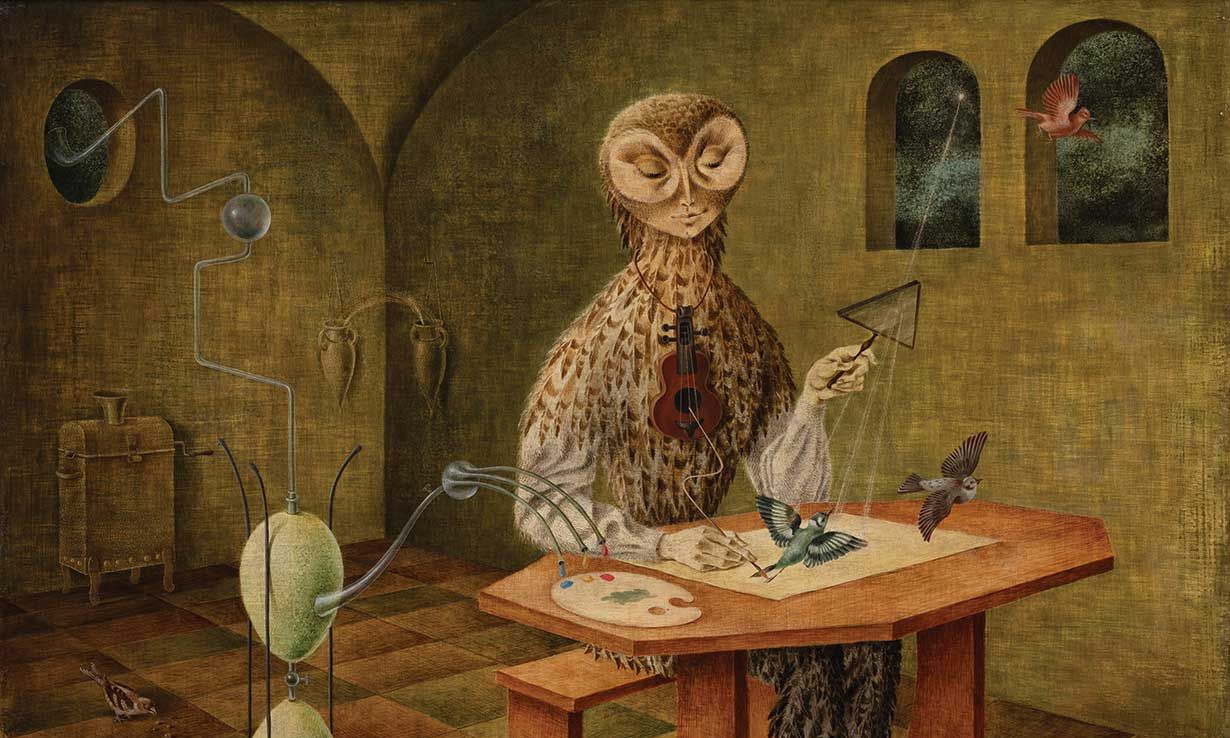“Mystical musicians and unconventional scientists”: Remedios Varo’s Creación de las Aves (creation of the birds, 1957) shows one of the artist’s characteristic compositions Photo: Rodrigo Chapa © 2023 Remedios Varo, ARS, NY/VEGAP, Madrid
The artist Remedios Varo (1908-63) was a voracious reader and a fan of science-fiction authors such as Jules Verne, Arthur C. Clarke and Ray Bradbury. Her paintings might seem like scenes out of a fantasy novel, too, with their steampunk protagonists conducting alchemical experiments, questing after new discoveries and communing with the cosmos. A new exhibition at the Art Institute of Chicago will present this singular body of work under the title Science Fictions, a phrase which the show’s press release says “alludes to the tensions and possibilities Varo brought together in her work as she searched to visualise hidden orders and unseen truths”.
Born María de los Remedios Alicia y Rodriga Varo y Uranga in Catalonia, Spain, the artist developed polymath interests at an early age. From her father, a hydraulic engineer, she learned about mathematics, technical drawing and linear perspective. She devoured books by Verne and others as an escape from her strict Catholic education at a convent school. Even before she enrolled in Madrid’s prestigious San Fernando fine arts academy—one of the only women to do so at the time—she was a regular visitor to the Old Masters in the Museo Nacional del Prado, studying works by Hieronymus Bosch and Francisco Goya.
Varo first encountered Surrealism as a student in the 1920s and began exhibiting with the surreal-leaning Logicofobista (phobia of logic) group in Barcelona a decade later. By 1937 she was mixing with the inner circle of the Surrealists in Paris, though she later recalled her position as one of a “timid and humble listener… open-mouthed within that group of brilliant and gifted people”. After the outbreak of the Second World War, she fled France for Mexico City, settling into a close-knit artistic community of European exiles alongside the Surrealist painter Leonora Carrington and the photographer Kati Horna. Together, the friends were dubbed “the three witches”.
It was in Mexico that Varo came into her own as an artist. In 1952 she gave up technical illustration and advertising to dedicate herself fully to painting and drawing. The Art Institute of Chicago exhibition, organised in partnership with Mexico City’s Museo de Arte Moderno, will bring together more than 25 works from the brief zenith of Varo’s career: from 1955, the year of her first show in her adopted country, to her untimely death in 1963. During this period, she said: “Today I do not belong to any group; I paint what occurs to me and that is all.”
Remedios Varo's Tauro (Taurus) (1962) © 2023 Remedios Varo, ARS, NY / VEGAP, Madrid. Photo: Rodrigo Chapa
For the curators, Caitlin Haskell of the Art Institute and the independent art historian Tere Arcq, Varo’s unique achievement was “to plumb art’s potential for material re-enchantment”, building up richly textured, “cosmic” surfaces to her paintings that matched the “expansive questions” of her imagination, they write in the exhibition catalogue.
New conservation research for the show, published in the catalogue, deconstructs Varo’s exquisitely precise techniques, reminiscent of the Old Master paintings she loved as a child. She chose inlaid mother-of-pearl, a material significant in shamanic rituals, to burnish the faces of the otherworldly figures in several paintings, and covered her panels in fine-grain scratches, possibly using quartz crystals that she ‘charged’ by moonlight and kept as talismans in the studio.
Varo's La huida (the escape, 1961) © 2023 Remedios Varo, ARS, NY / VEGAP, Madrid. Photo: Rodrigo Chapa
Such mystical motifs abound in Varo’s images. “Her symbols evoke wonder and enigma, as do her subjects, who include solitary wanderers, mystical musicians and unconventional scientists,” the curators write. The artist’s ideas were as multi-layered as her painted surfaces, blending “sources as wide-ranging as chivalric romance, ecology, esotericism (including tarot), feminist critique, mysticism and psychology”.
Varo’s knowledge-seeking protagonists emerge as “avatars” of the artist’s own continual search for spiritual transcendence beyond the visible world, the curators suggest. If the paintings seem mysterious, it is by design. As Varo told an interviewer the year before she died: “I deliberately proposed to make a mystical work, in the sense of revealing a mystery, or better, of expressing it through ways that do not always correspond to the logical order, but to an intuitive, divinatory and irrational order.”
• Remedios Varo: Science Fictions, Art Institute of Chicago, 29 July-27 November

